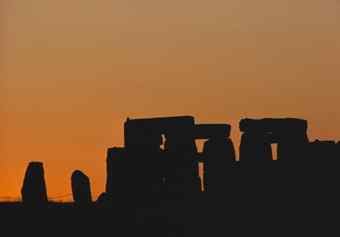New Agers and neo-pagans descended on Stonehenge to celebrate the summer solstice, each hoping to catch a glimpse of the sun as it rises above the ancient stone circle early Monday morning.
 The annual all-night party typically draws thousands of alternative-minded revelers to the prehistoric monument on Salisbury Plain as they wait for dawn at the Heel Stone, a pockmarked pillar just outside the circle proper which aligns with the rising sun.
The annual all-night party typically draws thousands of alternative-minded revelers to the prehistoric monument on Salisbury Plain as they wait for dawn at the Heel Stone, a pockmarked pillar just outside the circle proper which aligns with the rising sun.
"It means a lot to us ... being British and following our pagan roots," said Victoria Campbell, who sported a pair of white angel's wings and had a mass of multicolored flowers in her hair.
The 29-year-old Londoner, who works in the finance industry, also said that "getting away from the city" was a major draw.
"We're hoping for a clear night," she said.
Monday's sunrise, marking the longest day of the year north of the equator, is scheduled to occur over the circle at 4:52 a.m. local time (0352GMT.)
The annual celebrations at Stonehenge, about 80 miles (130 kilometers) southwest of the capital, are a modern twist on solstice celebrations which were once a highlight of the pre-Christian calendar. They survive today largely in the form of bonfires, maypole dances and courtship rituals.
Gina Pratt, a 43-year-old housewife and a self-described witch, said being inside the circle as the sun came up gave her "a kind of a grounding feeling (of) being in touch with the earth again, and the air we breathe."
Pratt, who wore a cape of crushed red velvet and wielded an amethyst-tipped wand, said the event gave rise to conflicting emotions.
"It makes you feel small and insignificant ... but it makes you feel like you're here for a reason," she said.
Stonehenge's origins remain a mystery, but theories suggest the grounds were part of a huge astronomical calendar. Others say an ancient sun worshipping culture aligned the structure with the midsummer sunrise and the midwinter sunset. The site was used as a cremation cemetery since its inception, archaeologists say, but it is unclear if that was its principal function.
"The truthful answer is we don't know exactly what it was for," said Amanda Chadburn, an archaeologist with English Heritage, which manages the site.
Whatever its origins, the construction of Stonehenge — built with massive stones drawn from up to 150 miles (240 kilometers) away — gives insight into an ancient culture, Chadburn said in an interview ahead of the solstice.
The World Heritage site was built in three phases between 3000 B.C. and 1600 B.C. It is one of Britain's most popular tourist attractions with more than 850,000 visitors a year. The solstice is one of the few times access is granted inside the stone circle, which has been roped off since 1978, following years of erosion and vandalism.
Police were on hand to ensure the event remained peaceful.
Source: The Christian Science Monitor